The Supertanker Arrives!
This one is going to be heavy on the pics, but I've sized things down to a fairly manageable download even if you're on dialup. And since I always specify my height and width attributes, you can read my wise prose while things are downloading! How about that!
First, the big event is the arrival of the Watermaster described by Fire Chief Phyllis Jackson in detail in the post below. We've been waiting for it for four months (at least), so we were as excited as the kids who showed up with their folks to see it. The tanker is somewhere in the neighborhood of $170,000, 95% paid for by DHS and 5% that we had to raise ourselves as matching funds. The Wolfskin Community responded very generously and we passed the $8500 mark at the end of January.
This was an impromptu training session, but curious folks did stop by. We'll be having a formal presentation to the community soon.
Let me introduce you to Phyllis. A lot of people worked hard on the grant, matching fundraising, and facilities to house the supertanker. Without Cary Fordyce none of us would have been able to negotiate the bewildering paths of the IRS and other entities. Lisa and Ed put in endless time with phone calls and footwork. Glenn took on the task of fundraising letters and thank yous. Frankie kept us in business, as always. But Phyllis had the original inspiration last March and provided much of the impetus, enthusiasm, and most of the grant writing ("We can DO this!"). And today she's a happy camper.
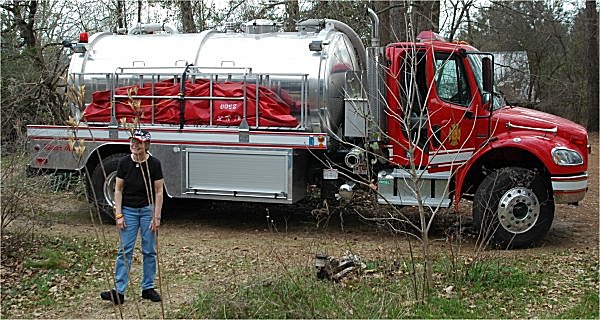
I arrived at Phyllis's (three miles away by road, but a half-mile if I tromp through the woods) at 3pm; the tanker had just arrived.
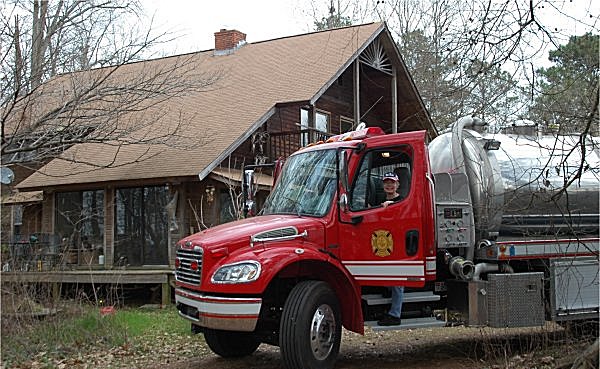
Here's the "wolf" skull (actually not) that Phyllis wired up with red LEDs.
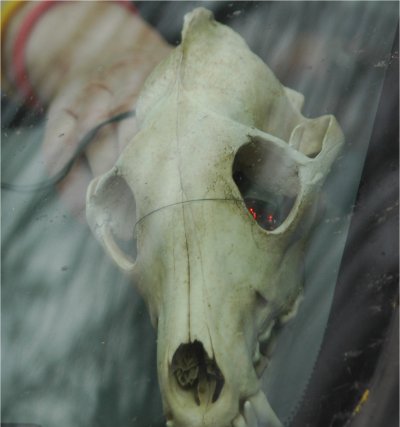
The tanker is a beast. 2500 gallons. Automatic transmission :-)
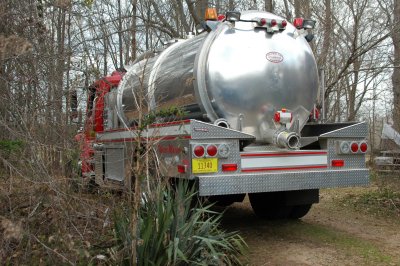
Now I know you're curious about the house you see in the background of one of the above pics. That's Phyllis' and Jeff's. Jeff is a wildlife biologist. They built the house gradually over several years and have added their own unique touches.
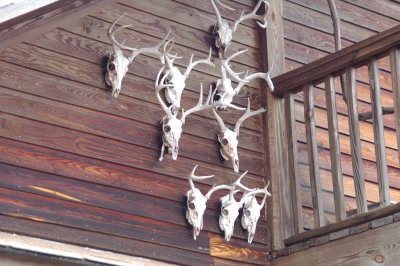
It was probably 12 years ago that we had a training session using ladders on their upstairs balcony.
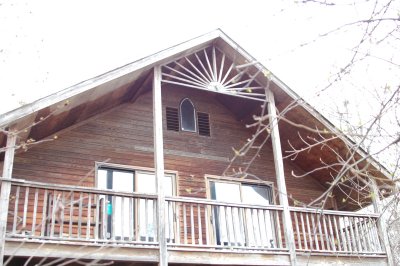
Isn't that an interesting ornamentation embroidering the trim? Let's look a little more closely.
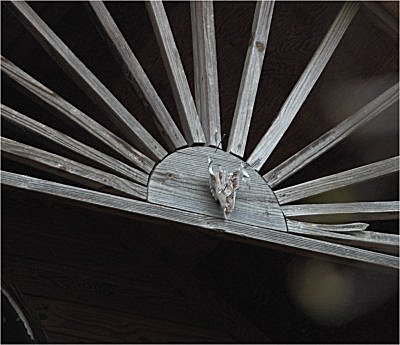
And then there's Frankie, on the left. Now Frankie is a sine qua non. Without whom nothing. He fixes things. He fixes everything. Right now he's trying to figure out how to fix something.
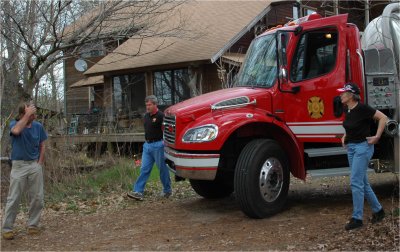
And then it was time to drive the tanker to WVFD to get ready for the fete. I could hardly keep up. The road, by the way, is Blacksnake Road.
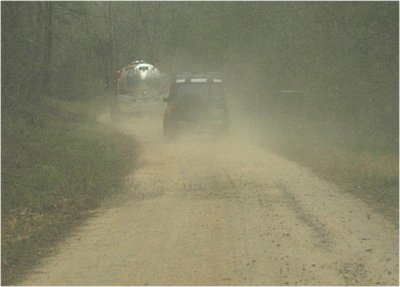
And here it is, 6pm already. I missed most of the fun part where it was discovered that the tanker, at 119" high, didn't quite fit under several items on the 121" high ceiling.
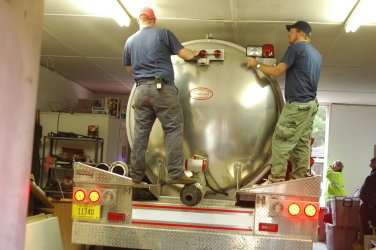
No problem for Frankie. He pulled off the stack, cut a few inches off, and put it back on. Presto!
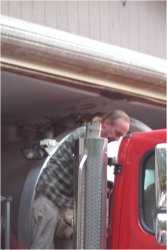
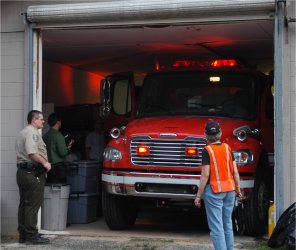
The brains of the system.
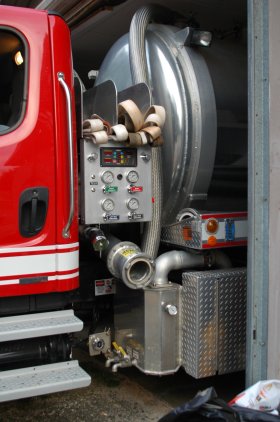

By this time, folks were arriving and it was time for company owner Richard O'Neill (in the yellow jacket) to show us how things are done. We're getting out the drop tank here. It's a big plastic tank that opens out. The idea is you drop your water from the tanker into it for other trucks to use, and then you take off to get more. (Or stay - the tanker is fully equipped as a regular pumper.) We must have filled it and sucked it back into the tanker a couple of dozen times during the course of the evening.
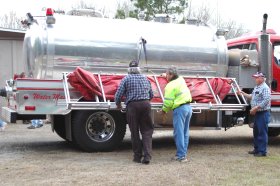
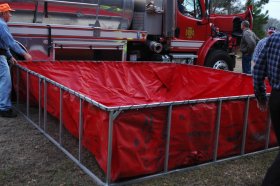
The hose is big because this tanker sucks water fast. It attaches to that neat metal strainer. The design is very clever. There's a seal air chamber so it can't turn upside down or sink, and it allows 2500 gallons to be pulled out of any body of water at least three inches deep, and in 2 minutes.
Around here you can't rely on fire hydrants. You make an onsite pond instead.
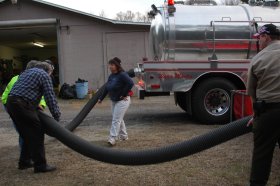

The drop tank is filled from the side of the truck. It can be filled slow, or really fast. The kids liked this a lot.
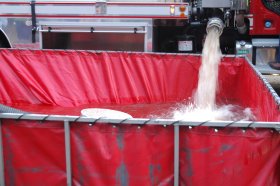
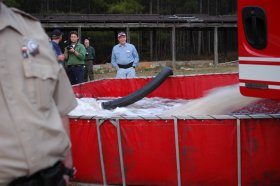
While this isn't necessarily normal procedure, we used the sucker to pull the water back into the truck, so it could be used again. Less than a minute to pull it all back in.
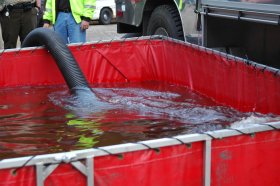
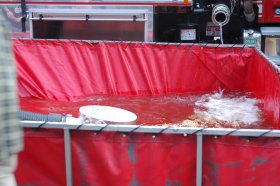
Everyone needed a lesson, so this went on well into the evening.
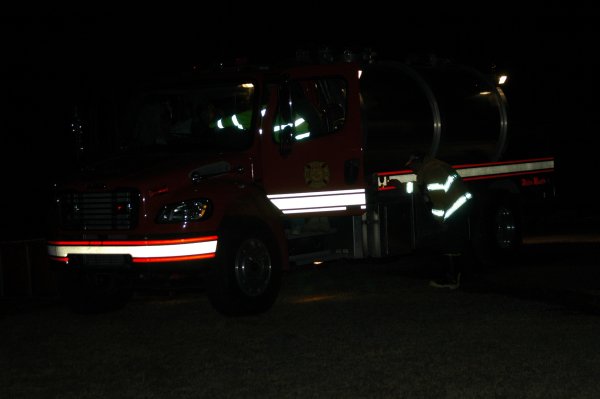



5 Comments:
This is such a great ending to a lot of work. Congratulations to you all.
BTW - why doesn't anyone ever comment here?
Tom - I guess they're shy. But thanks for doing so!
Don't get me wrong youve written a great piece and im glad for you but heres one thing that bothers me. A little place like yours gets a lot of money and other places that need it dont.
Linda, first - welcome.
You make a good point. As I see it including both internal emergencies (like fires and hurricanes and earthquakes) and external emergencies (such as terrorism) under the same department has been a bad thing. There's been a political tendency to give the same amount of money to Montana, for instance as to New York, for instance.
That aside -
Rural areas are handicapped, compared to urban areas. We don't have water hydrants, for instance. We rely on streams and ponds and lakes. We must have the equipment to get water in this way.
And we service larger areas than an urban fire department - WVFD services 35 square miles, if I recall correctly. True, there are fewer people, but not only do they care about their homes as much as urban dwellers but they typically pay MUCH higher insurance premiums for that protection.
One last thing -
Volunteer fire departments don't pay salaries. All that money goes to equipment.
Professional FDs such as you find in urban areas, with salaried employees on duty or call 24/7 are more efficient, but must cost somewhere around $100,000 per person when you take in salary and benefits. And I'd guess a professional FD keeps several people on duty for three 8-hour periods each. It's a huge cost.
By no means do I mean to belittle professional FDs - we VFDs rely on them greatly. But professional FDs usually get a lot of funding from State and Local sources that VFDs don't get (sometimes they should get that funding but it gets subverted in various ways).
OK - I said "finally" but one more thing and then I'll shut up:
WVFD wrote a grant proposal to get this money, something that goes way above and beyond what many FDs and VFDs do. We targeted our most critical need and asked for money for it - a truck that can carry lots of water that isn't available through hydrants. I think it was fairly granted.
Thanks foar the reply. I had not realized a lot of these things. I live in a medium city and didnt know rural areas have these kindsof fire probloems.
Post a Comment
<< Home